Music at William Paterson University of New Jersey
William Paterson University is located in Wayne, New Jersey and has a total student population of 9,635. In 2021, 42 music majors received their bachelor's degree from William Paterson University.
Want to know more about the career opportunities in this field? Check out the Careers in Music section at the bottom of this page.
Featured schools near , edit
William Paterson University Music Degrees Available
- Bachelor’s Degree in Music
- Master’s Degree in Music
William Paterson University Music Rankings
The following rankings from College Factual show how the music progam at William Paterson University compares to programs at other colleges and universities.
Note: Although rankings can help you see some information about a school, it's not a good idea to depend on them alone. Be sure to check out other things about the school before making your decision to attend.
Bachelor’s Degree Overall Quality & Other Notable Rankings
The music major at William Paterson University is not ranked on College Factual’s Best Colleges and Universities for Music. This could be for a number of reasons, such as not having enough data on the major or school to make an accurate assessment of its quality.
| Ranking Type | Rank |
|---|---|
| Most Focused Music Bachelor’s Degree Schools | 132 |
| Best Value Music Master’s Degree Schools | 150 |
| 357 | |
| 377 |
In 2021, 7 students received their master’s degree in music from William Paterson University. This makes it the #184 most popular school for music master’s degree candidates in the country.
Earnings of William Paterson University Music Graduates
The median salary of music students who receive their bachelor's degree at William Paterson University is $22,365. This is less than $24,982, which is the national average of all music majors in the nation who earn bachelor's degrees.
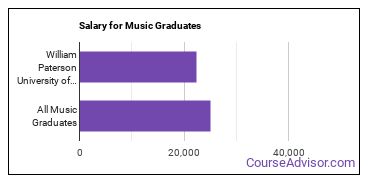
Music Student Demographics at William Paterson University
Take a look at the following statistics related to the make-up of the music majors at William Paterson University of New Jersey.
William Paterson University Music Bachelor’s Program
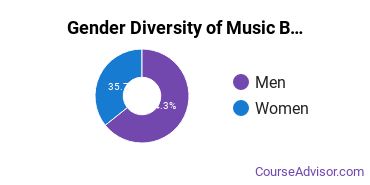
About 64% of those who receive a bachelor's degree in music at William Paterson University are white. This is above average for this degree on the nationwide level. Prospective students may be interested in knowing that this school graduates 2% more racial-ethnic minorities in its music bachelor's program than the national average.*
The following table and chart show the race/ethnicity for students who recently graduated from William Paterson University of New Jersey with a bachelor's in music.
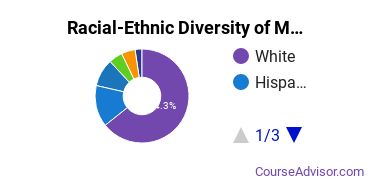
| Race/Ethnicity | Number of Students |
|---|---|
| Asian | 1 |
| Black or African American | 4 |
| Hispanic or Latino | 6 |
| White | 27 |
| International Students | 2 |
| Other Races/Ethnicities | 2 |
William Paterson University Music Master’s Program
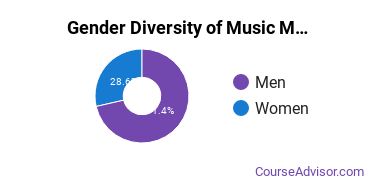
Of the students who received a music master's degree from William Paterson University, 71% were white. This is above average for this degree on the natiowide level.
The following table and chart show the race/ethnicity for students who recently graduated from William Paterson University of New Jersey with a master's in music.
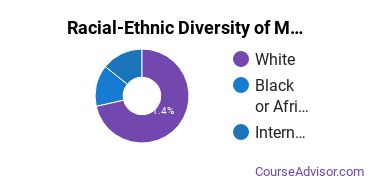
| Race/Ethnicity | Number of Students |
|---|---|
| Asian | 0 |
| Black or African American | 1 |
| Hispanic or Latino | 0 |
| White | 5 |
| International Students | 1 |
| Other Races/Ethnicities | 0 |
William Paterson University also has a doctoral program available in music. In 2021, 0 student graduated with a doctor's degree in this field.
Related Majors
Careers That Music Grads May Go Into
A degree in music can lead to the following careers. Since job numbers and average salaries can vary by geographic location, we have only included the numbers for NJ, the home state for William Paterson University of New Jersey.
| Occupation | Jobs in NJ | Average Salary in NJ |
|---|---|---|
| High School Teachers | 29,140 | $76,390 |
| Art, Drama, and Music Professors | 2,070 | $90,750 |
| Sound Engineering Technicians | 430 | $55,570 |
| Music Directors and Composers | 410 | $73,320 |
References
*The racial-ethnic minorities count is calculated by taking the total number of students and subtracting white students, international students, and students whose race/ethnicity was unknown. This number is then divided by the total number of students at the school to obtain the racial-ethnic minorities percentage.
- College Factual
- National Center for Education Statistics
- O*NET Online
- Image Credit: By No machine-readable author provided. NHRHS2010 assumed (based on copyright claims). under License
More about our data sources and methodologies.
Featured Schools
 Request Info
Request Info
|
Southern New Hampshire University You have goals. Southern New Hampshire University can help you get there. Whether you need a bachelor's degree to get into a career or want a master's degree to move up in your current career, SNHU has an online program for you. Find your degree from over 200 online programs. Learn More > |
